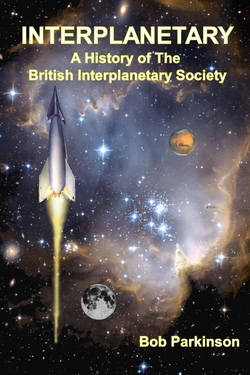Centauri Dreams
Imagining and Planning Interstellar Exploration
Explaining Earth’s Carbon: Enter the ‘Soot Line’
Let’s take a look at how Earth’s carbon came to be here, through the medium of two new papers. This is a process most scientists have assumed involved molecules in the original solar nebula that wound up on our world through accretion as the gases cooled and the carbon molecules precipitated. But the first of the papers (both by the same team, though with different lead authors) points out that gas molecules carrying carbon won’t do the trick. When carbon vaporizes, it does not condense back into a solid, and that calls for some explanation.
University of Michigan scientist Jie Li is lead author of the first paper, which appears in Science Advances. The analysis here says that carbon in the form of organic molecules produces much more volatile species when it is vaporized, and demands low temperatures to form solids. Moreover, says Li, it does not condense back into organic form.
“The condensation model has been widely used for decades. It assumes that during the formation of the sun, all of the planet’s elements got vaporized, and as the disk cooled, some of these gases condensed and supplied chemical ingredients to solid bodies. But that doesn’t work for carbon.”
Most of Earth’s carbon, the researchers believe, accumulated directly from the interstellar medium well after the protoplanetary disk had formed and warmed; it was never vaporized in the way the condensation model suggests. Interesting concepts come into play here, among them the cleverly titled ‘soot line,’ in analogy to the ‘snow line’ in planetary systems. This marker has a lot to do with how carbon behaves. The authors use astronomical observations and modeling to explore the concept. From the paper — watch what happens as the disk warms:
Astronomical observations show that approximately half of the cosmically available carbon entered the protoplanetary disk as volatile ices and the other half as carbonaceous organic solids. As the disk warms up from 20 K, all the volatile carbon carriers sublimate by 120 K, followed by the conversion of major refractory carbon carriers into CO and other gases near a characteristic temperature of ~500 K… The sublimation sequence of carbon exhibits a “cliff” where dust grains in an accreting disk lose most of their carbon to gas within a narrow temperature range near 500 K.
The ‘cliff’ is another good analogy. It’s the edge of the soot line:
The division between the stability fields of solid and gas carbon carriers corresponds to the “soot line,” a term coined to describe the location where the irreversible destruction of presolar polycyclic hydrocarbons via thermally driven reactions in the planet-forming region of disks occurred.
Modeling the sublimation process and loss of carbon in the solar nebula, the authors chart the soot line as it migrates with time as the system matures and the pressure and temperature of the disk evolve. Shortly after the birth of the Sun, the soot line might have extended out 10s of AU, but as the accretion rate diminished, it would have migrated inward. A carbon poor early Earth, then, would be the result of formation during the period when the soot line was well beyond Earth’s orbit, during the first million years, when accretion rates were high.
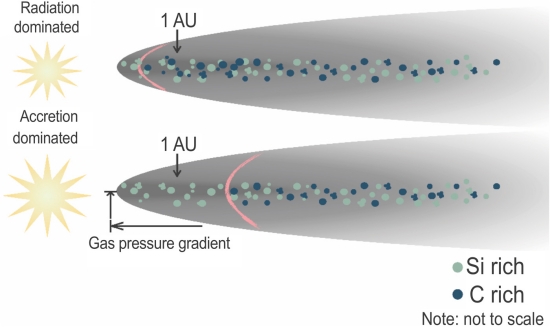
Image: This is Figure 2 from the paper. Caption: Fig. 2 Schematic illustration of the soot line in a protoplanetary disk: The soot line (red parabola) delineates the phase boundary between solid and gaseous carbon carriers. In the accretion-dominated disk phase, it is located far from the proto-Sun and divides carbon-poor dust and pebbles (green dots) from carbon-rich ones (dark blue dots). Within 1 Ma, as a result of the transition to a radiation-dominated, or passive, disk phase, the soot line migrates inside Earth’s current orbit. Note that the Si-rich and C-rich solids do not represent distinct reservoirs because carbonaceous material is likely associated with silicates. They are provided for ease in illustration. Credit: Li et al.
Drawing again from the paper:
If the bulk carbon content of Earth is low, then most of its source materials must have lost carbon through sublimation early in the nebula’s history or by additional processes such as planetesimal differentiation. Constraining the fraction of carbon-depleted source material accreted by Earth requires us to constrain the maximum amount of carbon in the bulk Earth.
Which the authors do by determining the maximum amount of carbon the Earth’s core could contain — after all, they mention planetary differentiation — a figure that turns out to be less than half a percent of Earth’s mass. Says Li’s colleague Edwin Bergin (University of Michigan):
“We asked how much carbon could you stuff in the Earth’s core and still be consistent with all the constraints. There’s uncertainty here. Let’s embrace the uncertainty to ask what are the true upper bounds for how much carbon is very deep in the Earth, and that will tell us the true landscape we’re within.”
The paper points to a severe carbon deficit in the newly formed Earth, and suggests still more about the environment producing it. Centimeter-to-meter sized pebbles delivering mass as they drift inward from the outer Solar System would carry both water and carbon. Simulations of their movement show that a giant planet core in the disk would create a pressure bump where drifting pebbles would pile up, diminishing the supply of carbon for the emerging inner system. The carbon-poor composition of iron meteorites is cited as evidence of this early carbon depletion.
In the second paper, the same group of researchers examined these iron meteorites, which represent the metallic cores of planetesimals, looking at how they retained carbon in their early formation. Here melting and loss of carbon is apparent. Marc Hirschmann (University of Minnesota) led the second study, which included the same co-authors along with Li:
“Most models have the carbon and other life-essential materials such as water and nitrogen going from the nebula into primitive rocky bodies, and these are then delivered to growing planets such as Earth or Mars.. But this skips a key step, in which the planetesimals lose much of their carbon before they accrete to the planets.”
Thus we see two different aspects of carbon loss, highlighting the delicate nature of carbon, so necessary for climate regulation but capable of creating Venus-like conditions when found in excess. The loss of carbon in the early Earth may play an essential role in our planet’s habitability. How carbon loss occurs in other planetary systems is a topic that will require a multidisciplinary approach involving both astronomy and geochemistry. As the second paper suggests, it’s a topic that could be vital to life’s chances elsewhere:
…the volatile-depleted character of parent body cores reflects processes that affected whole planetesimals. As the parent bodies of iron meteorites formed early in solar system history and likely represent survivors of a planetesimal population that was mostly consumed during planet formation, they are potentially good analogs for the compositions of planetesimals and embryos accreted to terrestrial planets. Less depleted chondritic bodies, which formed later and did not experience such significant devolatilization, are possibly less apt models for the building blocks of terrestrial planets. More globally, the process of terrestrial planet formation appears to be dominated by volatile carbon loss at all stages, making the journey of carbon-dominated interstellar precursors (C/Si > 1) to carbon-poor worlds inevitable.
Thus sublimation, not condensation, tells the tale of carbon abundance on Earth, with presumably the same processes at work elsewhere in the galaxy.
The Li paper is “Earth’s carbon deficit caused by early loss through irreversible sublimation,” Science Advances Vol. 7, No. 14 (2 April 2021). Full text. The Hirschmann paper is “Early volatile depletion on planetesimals inferred from C-S systematics of iron meteorite parent bodies,” Proceedings of the National Academy of Sciences Vol. 118 (30 March 2021). Full text.

Roman Space Telescope: Planets in the Tens of Thousands
The Nancy Grace Roman Space Telescope is the instrument until recently known as WFIRST (Wide-Field Infrared Survey Telescope), a fact I’ll mention here for the last time just because there are so many articles about WFIRST in the archives. From now on, I’ll just refer to the Roman Space Telescope, or RST. Given our focus on exoplanet research, we should keep in mind that the project’s history has been heavily influenced by concepts for studying dark energy and the expansion history of the cosmos. The exoplanet component has grown, however, into a vital part of the mission, and now includes both gravitational microlensing and transit studies.
We’ve discussed both methods frequently in these pages, so I’ll just note that microlensing relies on the movement of a star and its accompanying planetary system in front of a background star, allowing the detection because of the resultant brightening of the background star’s light. We’re seeing the effects of the warping of spacetime caused by the nearer objects, with the brightening carrying the data on one or more planets around the central star. You can see why a target-rich environment is needed here — such occulations are random and lots of stars are needed to cull out a few. Thus RST looks toward galactic center.
Assuming a successful launch and operations beginning in the mid-2020s, the RST should be a prolific planet-hunter indeed. NASA is now projecting, based on a 2017 paper from Benjamin Montet (now at the University of New South Wales) and colleagues, that the anticipated light curves for millions of stars should turn up as many as 100,000 planets. Montet et al. actually cite as many as 150,000, noting that the WFIRST field is more metal rich than the main Kepler field. All of these systems should have measured parallaxes, though most will be too faint for follow-ups.
Even so, the Montet paper finds ways to confirm some of these:
We find that secondary eclipse depth measurements can be used to confirm as many as 2900 giant planets, which can be detected at distances of > 8 kpc. From these confirmed WFIRST planets, we will be able to measure the variation in the occurrence rate of short-period giant planets. Furthermore, we show that WFIRST is capable of detecting TTVs which can be used to confirm the planetary nature of some systems, especially those with smaller planets.
This is particularly fruitful — consider that the transiting planets that RST finds will in most cases not be found around the same host stars as the planets found through microlensing. The two methods enable separate probes of the same population of planets but at different separations, with transits being most detectable for close-in planets and microlensing being the method to detect planets much further out in the system. We go from star-hugging hot Jupiters to planets beyond 10 AU. Microlensing should also turn up free-floating ‘rogue’ planets.
The Kepler mission studied stars in an area encompassing parts of Lyra, Cygnus and Draco, most of them ranging from 600 to 3,000 light years away. With RST, we will be going from Kepler’s 115 square degree field of view of relatively nearby stars to a 3 square degree field that, because it is toward galactic center, will track up to 200 million stars. The average distance of stars in this field will be in the range of 10,000 light years in what will be the first space-based microlensing survey, looking at planets all a wide range of distance from the host star.
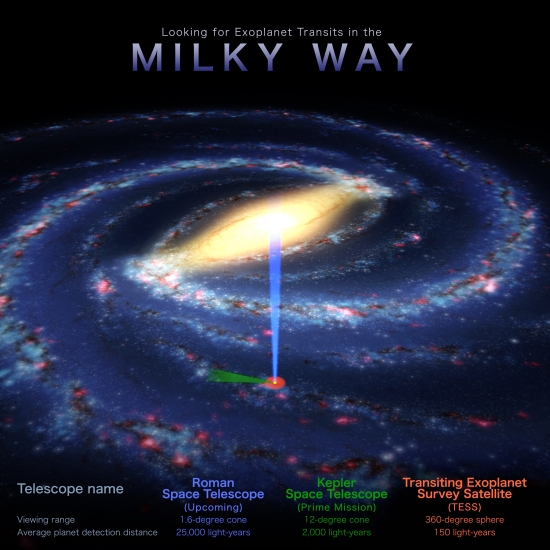
Image: This graphic highlights the search areas of three planet-hunting missions: the upcoming Nancy Grace Roman Space Telescope, the Transiting Exoplanet Survey Satellite (TESS), and the retired Kepler Space Telescope. Astronomers expect Roman to discover roughly 100,000 transiting planets, worlds that periodically dim the light of their stars as they cross in front of them. While other missions, including Kepler’s extended K2 survey (not pictured in this graphic), have unveiled relatively nearby planets, Roman will reveal a wealth of worlds much farther from home. Credit: NASA’s Goddard Space Flight Center.
The synergy between microlensing and transit work is clear. Jennifer Yee, an astrophysicist at the Center for Astrophysics | Harvard & Smithsonian, notes that thousands of transiting planets are going to turn up within the microlensing data. “It’s free science,” says Yee. Benjamin Montet agrees:
“Microlensing events are rare and occur quickly, so you need to look at a lot of stars repeatedly and precisely measure brightness changes to detect them. Those are exactly the same things you need to do to find transiting planets, so by creating a robust microlensing survey, Roman will produce a nice transit survey as well.”
So we’ve gone from the relatively close — Kepler with stars at an average distance of 2,000 light years — to the much closer — TESS, with its scans of the entire sky focusing in particular on stars in the range of 150 light years — and now to RST, which backs out all the way to galactic center, a field encompassing stars as far as 26,000 light years away. NASA estimates that three-quarters of the transits RST detects will be gas or ice giants, with most of the rest being planets between four and eight times as massive as Earth, the intriguing ‘mini-Neptunes.’ For its part, microlensing takes us down to rocky planets smaller than Mars and up to gas giant size.
The Montet paper is “Measuring the Galactic Distribution of Transiting Planets with WFIRST,” Publications of the Astronomical Society of the Pacific Vol. 129, No. 974 (24 February 2017). Abstract.

Uranus: Detection of X-rays and their Implications
Just as Earth’s atmosphere scatters light from the Sun, both Jupiter and Saturn scatter X-rays produced by our star. In a new study using data from the Chandra X-ray Observatory, we now learn that Uranus likewise scatters X-rays, but with an interesting twist. For there is a hint — and only a hint — that scattering is only one of the processes at work here, and that could produce insights into a system that thus far we have been able to study up close only once, through the flyby of Voyager 2. As the paper on this work notes: “These fluxes exceed expectations from scattered solar emission alone.” Just what is going on here will demand further work.
William Dunn (University College London) is lead author of the paper, which includes co-authors from an international team working with Chandra data from 2002 and 2017. In the image below, the X-ray data from Chandra is superimposed upon a 2004 observation of Uranus from the Keck telescope, which shows the planet at essentially the same orientation as the 2002 Chandra observations. Any image of Uranus reminds us that the ice giant, about four times Earth’s diameter, rotates on its side, with twin sets of rings around the equator.
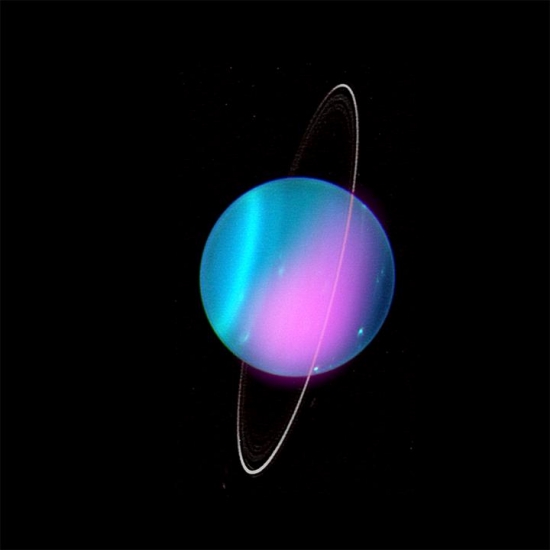
Image: The first X-rays from Uranus have been captured by Chandra during observations obtained in 2002 and 2017, a discovery that may help scientists learn more about this ice giant planet. Researchers think most of the X-rays come from solar X-rays that scatter off the Uranus’s atmosphere as well as its ring system. Some of the X-rays may also be from auroras on Uranus, a phenomenon that has previously been observed at other wavelengths. This Uranus image is a composite of optical light from the Keck telescope in Hawaii (blue and white) and X-ray data from Chandra (pink). Credit: X-ray: NASA/CXO/University College London/W. Dunn et al; Optical: W.M. Keck Observatory.
Uranus’ orientation is significant given that its rotation axis is almost parallel to the plane of its orbit. Moreover, the tilt of the rotation axis differs from that of the planet’s magnetic field and is also offset from the planet’s center. That should play into the auroral activity observed on Uranus, a useful trait because exactly how the auroral process works has not been determined. On Earth, auroras are the result of electrons traveling along the planet’s magnetic field lines to the poles, and we likewise find auroral activity on Jupiter, where a similar effect is in play. But the Jovian auroras are also fired by positively charged atoms entering the polar regions.
Are the auroras of Uranus one source of the recently detected X-rays? The possibility remains in the mix pending further study. Given that X-rays are emitted on Earth and Jupiter as a result of auroral activity, the unusual axial and magnetic field tilt on Uranus may clarify our understanding of the process, while illuminating how other astrophysical objects emit X-rays.
Without further data, the authors can only speculate, but they see another possible cause in the rings of Uranus. The rings of Saturn are known to produce X-rays, and it is possible that the interactions of the Uranian rings with charged particles could cause an X-ray glow that is detectable.
As we learn more, it’s clear that Uranus is an interesting laboratory for X-ray work, with a highly variable magnetosphere interacting in complicated ways with the solar wind. That hint of processes beyond X-ray scattering, however, may point to an actual mechanism for their production or, as the authors note, may be no more than a statistical fluctuation in the Chandra data. How we develop this picture depends upon further Chandra work and possibly data from XMM-Newton, the European Space Agency’s X-ray observatory. The roadmap for that investigation is explained in the paper:
…an observation lasting a few XMM?Newton orbits would be needed to provide a Uranus X?ray spectrum that could be modeled. This would enable a deeper characterization of the spectrum from Uranus, to explore, for example, the presence of fluorescence line emissions from the rings. Further, and longer, observations with Chandra would help to produce a map of X?ray emission across Uranus and to identify, with better signal?to?noise, the source locations for the X?rays, constraining possible contributions from the rings and aurora. Such longer timescale observations would also permit exploration of whether the emissions vary in phase with rotation, potentially suggestive of auroral emissions rotating in and out of view.
The paper is Dunn et al., “A Low Signal Detection of X?Rays From Uranus,” JGR Space Physics 31 March 2021 (Abstract / Full Text).

2I/Borisov: A Remarkably Pristine Interstellar Comet
The beauty of comet 2I/Borisov, the second interstellar object discovered in our Solar System, is that it looks and acts more or less like, well, an interstellar comet, without the puzzling characteristics of its predecessor, the still controversial ‘Oumuamua. 2I/Borisov’s cometary nature is clear in the latest observations from the European Southern Observatory’s Very Large Telescope, data from which also tell us that this is one of the most undisturbed relics of a circumstellar disk ever found. Scientists believe it never passed close to any star before its 2019 passage by the Sun.
We don’t know around which star it formed, but Stefano Bagnulo (Armagh Observatory and Planetarium, Northern Ireland), lead author of one of two new papers on the object, says that 2I/Borisov “could represent the first truly pristine comet ever observed.” Bagnulo’s team used the FORS2 instrument on the VLT (FOcal Reducer and low dispersion Spectrograph), an instrument that can take spectra as well as measuring polarization.
That later capability, called polarimetry, helps astronomers understand the chemistry of comets by studying how sunlight is polarized by a comet’s dust. The technique has been used on small bodies in the Solar System including comets, making for interesting comparisons. For 2I/Borisov’s polarimetric properties differ from Solar System comets with the exception of one, comet Hale-Bopp, which was likewise one of the most pristine comets observed to that time.
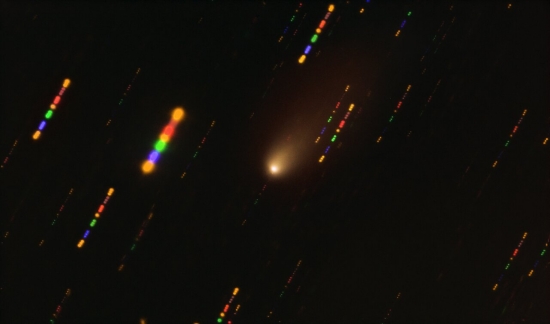
Image: Taken with the FORS2 instrument on ESO’s Very Large Telescope in late 2019, when comet 2I/Borisov passed near the Sun. Here the background stars appear as streaks of light as the telescope followed the comet’s trajectory. The colours in this composite image are the result of combining observations in different wavelength bands. Credit: ESO/O. Hainaut.
You may recall Hale-Bopp from the late 1990s, when it was a naked eye object (I remember a total stranger offering up a view in his small telescope on a nearby parking lot one night). A comet like this would be little affected by the solar wind and other radiation, thus having a composition similar to the original cloud of gas and dust that produced it. But Hale-Bopp was thought to have made one pass by the Sun before its recent visitation, while 2I/Borisov shows every sign of being a complete newcomer to the inner regions of a star.
Two interesting points from the paper:
…at the time of our observations, comet 2I/Borisov was polarimetrically homogeneous, showing no sign of active areas contributing to the coma formation. Prior to its recent perihelion passage, comet Hale-Bopp probably was near the Sun at least once, and possibly only once, ~2250?BC; at the time of that first approach, the original material was removed from the surface and active areas were open, hence Hale-Bopp could manifest activity during its recent perihelion passage. Comet 2I/Borisov instead, most likely never passed close to the Sun or any other star, and may represent the first truly pristine comet that has ever been observed.
That’s useful information in the context of what follows, as we learn in this paper that 2I/Borisov’s composition is consistent with objects that emerged close to home:
The similarity between the polarimetric properties of the two comets must depend upon the microscopic structure and composition of the aggregates, and not on their macroscopic characteristics, as the two comets are quite different in size: the analysis of the photometric profile of the inner coma suggests that comet Hale-Bopp belongs to the class of giant comets, with the diameter of the nucleus being estimated between 20 and 35?km, while 2I/Borisov’s nucleus size is ? 0.4?km. The close similarity between the polarimetric behaviour of the comet 2I/Borisov and Hale-Bopp suggests that, whatever astrophysical environment in which comet 2I/Borisov originated in, such environment had properties which led to the formation of a body bearing significant analogies with those accreted in the outer regions of our Solar System, a remarkable result on its own.
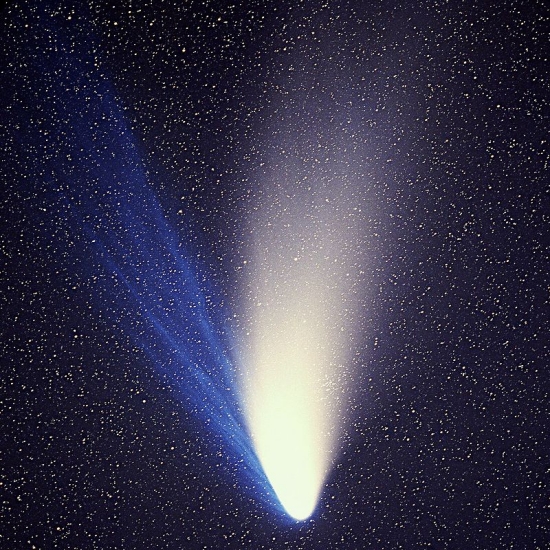
Image: Image of comet C/1995 O1 (Hale-Bopp), taken on 1997 April 04, with a 225mm f/2.0 Schmidt Camera (focal length 450mm) on Kodak Panther 400 color slide film with an exposure time of 10 minutes. The field shown is about 6.5°x6.5°. At full resolution, the stars in the image appear slightly elongated, as the camera tracked the comet during the exposure. Credit: E. Kolmhofer, H. Raab; Johannes-Kepler-Observatory, Linz, Austria (http://www.sternwarte.at) – Own work, CC BY-SA 3.0.
In a second paper on the interstellar comet, ESO astronomer Bin Yang used data from the Atacama Large Millimeter/submillimeter Array (ALMA) to study 2I/Borisov’s dust grains. Here the key finding is that the coma of the comet surrounding the nucleus contains dust grains of one millimeter or larger. The relative amounts of carbon dioxide and water also changed as the comet neared perihelion, an indication that mixing of materials occurred where it formed. We can begin to deduce interesting things about the home system of this interstellar comet:
Our ALMA and VLT observations indicate that 2I/Borisov’s home planetary system, much like our own Solar system, had experienced efficient radial mixing from the innermost parts of its protoplanetary disk to beyond the frost line of CO. Among a number of probable mechanisms that have been proposed for the origin of ISOs [interstellar objects], gravitational interactions between planetesimals in the protoplanetary disk and growing giant planets is favored, as it can explain both the ejection of ISOs from their home systems as well as account for the strong radial transport of materials in the disk. While the most common planets in other exoplanetary systems seem to be super-Earths and mini-Neptunes, our study suggests the presence of giant planets in the home system of 2I/Borisov.
The first paper is Bagnulo, et al., “Unusual polarimetric properties for interstellar comet 2I/Borisov,” Nature Communications 12, No. 1797 (30 March 2021). Abstact/Full Text. The second paper is Bin Yang et al., “Compact pebbles and the evolution of volatiles in the interstellar comet 2I/Borisov,” Nature Astronomy 30 March 2021. Abstract.

Shaping Circumstellar Disks
The circumstellar disks that give rise to planets occur in huge variety depending on the nature of star formation around them. Such disks form early as stars emerge, according to some recent work appearing within 10,000 years after the birth of the star. New work out of Leiden University in The Netherlands homes in on the environmental factors shaping the evolution of these disks, giving us a sense of how stellar systems differentiate as their planetary configurations form.
The work, led by Francisca Concha-Ramírez, offers up a model of circumstellar disk formation in young star-forming regions. The formation model is a mathematical treatment that begins with the collapse of a giant molecular cloud and the subsequent formation of stars in a variety of masses, velocities and positions within a cluster. The disk formation model sets stellar evolution into motion at the same time as disk formation to study the interactions between the two as star-forming regions of varying densities emerge.
So a variety of astrophysical processes are at work simultaneously in these simulations, including not just stellar dynamics as the molecular cloud collapses but the effects of nearby young stars through processes like photoevaporation. In the latter, the disk surface evaporates due to radiation from the host star, or just as significantly, from bright stars nearby in the cluster. Areas of a disk can be cleared by host star radiation, while radiation from nearby stars can deplete in particular the outer regions of disks, where material is less bound to the host star.
No wonder we see the variety displayed in the image below. If nearby stars deplete a circumstellar disk too swiftly, planet formation becomes impossible.
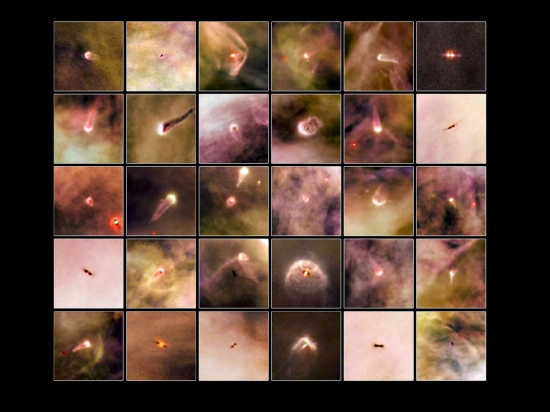
Image: Circumstellar discs in the Orion Nebula, observed with the Hubble Space Telescope. The ‘comet tail’-like structures show disks being evaporated by nearby bright stars. Credit: NASA/ESA, L. Ricci (ESO).
As you would imagine, this work gives us a wide variety of potential disk-modifying events. In young star clusters, close encounters from stellar flybys can affect the size and shape as well as surface density of the disks, sometimes forcing the appearance of spiral arms. Disks can exchange mass and tidal streams can emerge, all found in recent disk observations. The outer edge of a disk can become truncated by the passage of a nearby star. In fact, lead author Concha-Ramírez thinks this may have occurred in our own early Solar System:
“A collision may have taken place between our circumstellar disc and another disc. We can see proof of this at the edge of our Solar System, in the region of the planet Neptune. Here there are suddenly much fewer asteroids, which suggests that another disc could have nabbed material. And there is another interesting clue that there might have been a collision between discs: asteroids that, in relation to the Earth, orbit the sun on a different plane. These asteroids probably come from another disc.”
That’s a controversial ‘probably,’ but Concha-Ramírez is pointing to the so-called Sednitos that move in the outer regions of the Solar System between the Kuiper Belt and the Oort Cloud, whose origin is still up for grabs. Other observational evidence of disk-shaping by the environment can be found in the Orion Nebula, where we see ‘proplyds,’ circumstellar disks that are swathed in the radiation of tightly spaced stars. Here we can find cometary tail-like structures, and mass loss as disks closest to massive stars experience photoevaporation.
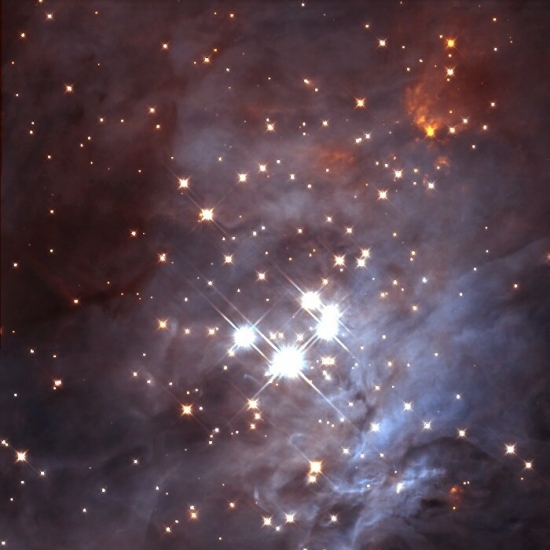
Image: The Trapezium cluster, in the Orion Nebula. This is similar to the regions Concha-Ramírez simulated. Credit: NASA; K.L. Luhman (Harvard-Smithsonian Center for Astrophysics, Cambridge, Mass.); and G. Schneider, E. Young, G. Rieke, A. Cotera, H. Chen, M. Rieke, R. Thompson (Steward Observatory, University of Arizona, Tucson, Ariz.)
In general, disk masses decrease as the density of nearby stars increases, but the authors are quick to add that massive disks can still form in regions like these. About 60 percent of the disks are destroyed by photoevaporation within the first 100,000 years of evolution in high density star regions, but in these simulations, massive radiating stars do not all form at the same time, and tend to emerge later than low mass stars. This would give some massive disks more time to evolve. Gas present in the clusters also has a protective effect and helps to explain the proplyds found in Orion, which have found a path to persist despite intense external radiation.
The catalog of disks emerging out of all this seems to be as broad as the catalog of the planets that emerge within them. Making the call on which disks will survive and in what form is a matter of sorting all of these factors on a case by case basis. From the paper:
…while photoevaporation is an important process for the depletion of disc masses, other factors such as the morphology of the star-forming regions and the length of the star formation process can allow for circumstellar discs to survive for long periods of time, and to remain massive enough to form planets. This could help explain the great variety of disc mass distributions observed in star-forming regions of different ages and configurations, and could also be a factor in solving the ‘proplyd-lifetime problem’, where massive discs are observed in regions of high stellar density and background radiation.
The paper is Concha-Ramirez et al., “Evolution of circumstellar discs in young star-forming regions,” submitted to Monthly Notices of the Royal Astronomical Society (preprint).

Theia: Tracking Remnants of the ‘Big Whack’
The ‘Big Whack,’ as I’ve heard it called, is the impact of a planetary embryo of perhaps Mars-size (or larger) that is thought to have struck the Earth during the latter era of planet formation. Or we can call it the ‘Giant Impact,’ as Arizona State scientists did in a presentation at the virtual Lunar and Planetary Science Conference recently concluded. Whatever the name, the event offers a model for the formation of the Moon, one that explains the latter’s small iron core and the anomalous high degree of angular momentum of the Earth-Moon system.

The impact of the protoplanet called Theia would have been a fearsome thing, blasting pieces of both worlds into space that later coalesced into the Moon. Think When Worlds Collide, the 1933 science fiction novel written by Philip Wylie and Edwin Balmer, whose cover is irresistible and thus must be reproduced here. Better known, of course, is the 1951 film of the same name, produced by George Pal. Neither has anything to do with the Moon but vast objects running into each other offer possibilities Hollywood was bound to seize at some point.
The new work on the Moon’s formation is less photogenic, but it draws on a detectable feature within the mantle of the Earth, so-called Large Low Shear Velocity Provinces (LLSVPs), which have been confirmed through seismic wave detections. The slowing of seismic waves that encounter LLSVPs is an indication that the material they’re made of is denser than the rest of the mantle, and indeed they seem to rest on the rim of the outer core, which is itself telling.
The work is complicated by the lack of agreement on the size of Theia and questions about its composition, as a description in the Lunar and Planetary Science Conference materials (LPI Contrib. No. 2548) makes clear:
…one of the most critical issues related to this scenario is that no evidence has been found for the existence of the hypothesized planetary embryo Theia. This is in part because of its widely debated size ranging from 0.1~0.45 Earth mass (M?) [5] and enstatite to carbonaceous chondrite composition [6]–[9]. Moreover, whereas it is mostly agreed that the core of Theia promptly merged with the proto-Earth core shortly after the impact [3], what fraction of and how the Theia mantle was preserved into the Earth mantle remain elusive. This post-impact process is not only responsible for the initial thermal and compositional structures of the Earth, but also significantly affects Earth’s long-term chemical evolution.

Image: The Giant Impact hypothesis for the origin of the LLSVPs. Credit: Li et al.
Did intact pieces of Theia’s mantle survive inside the Earth? The Arizona State study indicates that some of these materials account for the Large Low Shear Velocity Provinces, sinking to the bottom of Earth’s mantle in the process. The authors use numerical modeling experiments to support the idea, working with mantle materials from both Theia and the Earth as key components and producing models where the Theia materials sink and survive.
The key here is the density of the Theia mantle, allowing the material to survive mixing by convection within Earth’s mantle as long as it is denser than the material around it. The analysis suggests that the Theia materials were rich in iron and several percent denser, allowing them to sink to Earth’s lowest mantle and accumulate into the LLSVPs. The initial thickness of the Theia mantle materials in this model is in a range between 350 kilometers and 500 kilometers, existing as chunks of a protoplanet in the form of LLSVPs beneath Africa and the Pacific Ocean.
For more, see Yuan et al., “Giant Impact Origin for the Large Low Shear Velocity Provinces,” 52nd Lunar and Planetary Science Conference 2021 (LPI Contrib. No. 2548), available here. The paper is in process at Geophysical Research Letters.

